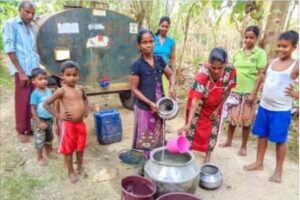
Drought plays havoc
.jpg)
All nine provinces in the country are suffering from a severe drought due to insufficient rainfall. The government requests the residents in these areas to use water with much care and minimize wastage, especially due to the despite the little rainfall received in the past few weeks. The country’s drinking water crisis continues as storage levels of many tanks have dropped drastically. What is worse is that according to the Meteorological Department there will be no rain in these areas until October.
The latest data on electricity generation for 2016 and up to March 2017 released by the Public Utilities Commission of Sri Lanka (PUCSL) shows the sharp impact of the drought on hydro electricity generation. By Q4 2016 and Q1 2017 reservoir levels were at their lowest in five years, and this has had a major impact on the cost of electricity generation as the CEB had to switch to thermal generation. At a higher cost. CEB hydropower generation in Q1 of this year (2017) was the lowest compared to Q1 of the past three years.
Since June/July, 2016 through to March 2017, electricity generation in all hydropower stations was halved (or more) due to the drought. On average every month, the top 6 largest hydropower plants were operating at a fraction of their full capacity.
Irrigation
Irrigation mainly for agriculture purpose has been highly affected by the drought and many agriculture farmers are finding it difficult to maintain their cultivations. Due to low production, vegetable prices have been rising over the time. According to Wasantha Bandara Palugaswewa, Director Irrigation, Water Management, and Training, Department of Irrigation, out of major tanks 73 have got only 15 per cent of overall capacity.
“We have completely cut down the water supply to paddy fields in drought affected areas at the moment,” Palugaswewa said. “We carefully manage water with the help of Sri Lanka Police and I hope we can save the crops,” he added.
Cultivations and farms
The prevailing dry weather conditions are severely damaging the crop production as well as the livestock industry in the country. The drought that lasted for nearly eight months has turned into a crisis situation for many cultivators as well as the farmers in affected areas.
For most of the farmers, it is the worst condition they have seen in decades. Survival has become their only goal as there is no sign of rain for months. Namal Karunarathne, National Organizer, All Ceylon Peasants’ Federation said, ” 118 District Secretariats have been affected by the drought. Areas like Vilachchiya in the North Central Province, which I have visited personally many cultivators are suffering without water even for their consumption like drinking, washing, and cooking. The situation in Ampara remains the same.
“Sri Lanka has enough rivers but we don’t utilize these rivers in a proper manner,” he added. “Many major rivers have been blocked to generate electricity, but what I suggest is generating electricity has many options but agriculture does not. So we should utilize our river water mainly for agriculture and find out alternatives to generate electricity,” Karunarathne said.
Dairy farmers
Not only cultivators but also dairy farmers have equally been affected, he further stated. Especially in areas like Trincomalee, Seruvila and Vilachchiya cattle do not have enough water to drink and some farmers have started selling their herd for meat since they do not have a way of providing food and water. “Dry weather has eliminated many grazing areas and also the government has restricted cattle from entering forest reserves which I think is not fair,” he said. These innocent dairy farmers and their cattle do not harm the forest. I think the government should call an emergency situation for this drought and seek international assistance and aid to stop people suffering.
However, a senior official from a leading dairy company, one of the country’s leading milk-based product manufacturer said they have not seen any decline in their milk supply. “Some of the small scale private milk collectors have stopped purchasing milk from dairy farmers and I do not know whether that is the reason for our supply to remain the same even in areas like Batticaloa, Anuradhapura and Ampara which are severely affected by the drought,” he added. “I think nowadays most of the dairy farmers do not send their cows to the jungle for grazing, but they provide food and water by themselves. So these cattle are not affected by the drought, he further stated.
Disaster management measures
We see a drastic change in the world’s climate and many forest covers having been cut down for various development purposes which lead to the long lasting droughts as well as the drop in ground water levels. According to the National Disaster Management Centre (NDMC) data, more than one million people are suffering for nearly eight months in all the nine provinces in the country due to the ongoing dry weather. The government has already sanctioned more than Rs 40 million to District Secretaries mainly to address the drinking water issue. More than 6,000 tanks have been allocated in many different locations to provide clean drinking water to the affected communities.
Pradeep Kodippili, Assistant Director, NDMC said still some of the areas are not getting sufficient amount of drinking water. Within the 2-3 months we have provided 200 water bowsers and we have been providing them for some time, he added. The Northern Province is the worst affected and even most of the areas in the Eastern Province have not received rain.
Answering a question on whether there were any funds distributed among the affected residents he said funds had been distributed to farmers for their damaged crops for the eight months of drought. The Ministry of Disaster Management has established Disaster Management Units to coordinate ground level conditions. The drought has affected the whole economic situation in these areas Kodippili added. “I should say that the areas like Kalutara and Moneragala which were also affected by the drought have come out of danger as these areas have started experiencing sufficient rainfalls.
“And we are continuing our funding to provide drinking water to drought affected areas,” he said. We have enough funds allocated. We have provided a 24-hour service to the residents so that they can call us if they are in need of drinking water.
Drought mitigation projects
As a long-term measure the NDMC carries out drought mitigation projects which include rainwater harvesting projects and constructing irrigation wells. “We hope to expand our drought mitigation measures with more funds in the future,” Kodippili said. “The government is working on a project with the Arthur C. Clarke Centre for monitoring droughts and predicting them in the future.” he added.
Kodippili also said, “The people need to save water especially and they should properly utilize rain water. There should be a proper mechanism to protect the existing water bodies without getting contaminated.
The country also needs new policies or revise the existing ones in order to face disasters such as droughts.”
Global climate is changing rapidly resulting in many natural disasters in various parts of the world.
As a country with a proud history of being the number one rice producer in the region Sri Lankans had the best practice of using tanks and other water bodies. Both traditional knowledge and discipline were around the use of water.
Many of these practices have disappeared over time. Traditional crop patterns have not been followed by many farmers while encroachments and dumping of waste have increased rapidly. Rapid development has led to the clearance of many natural forest covers.
As a result, we are dealing with more natural disasters such as floods, droughts, cyclones and even landslides causing many deaths and damage to residents. Drought conditions are getting worse day by day in several provinces, and the extremely hot weather has led to stress in daily life and damage to crops and livestock. Preparedness, awareness and proper management of forests and water bodies can only minimize the effects of these harsh weather conditions and no government can alone work towards them.
source – ceylon today, See more at – http://www.ceylontoday.lk/print20170401CT20170630.php?id=27087

Projects to check growing garbage crisis
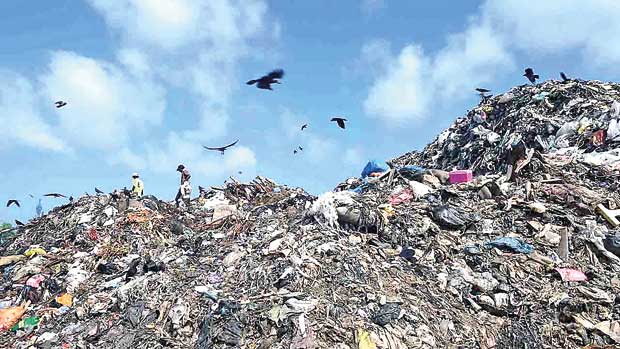
Garbage is not a problem only in Sri Lanka, but also in the rest of the countries. What is vital in this case is not how muck is collected in countries, but how the collected garbage is properly managed and recycled. It is evident how the garbage issue has affected our people and the country owing to the lack of management mechanism to utilize garbage.
I don’t want to reiterate the tragedy and the trouble caused to the people. It is pointless to claim how much garbage is collected. The governing body and its institutions should address the issue positively and take prompt actions to manage and recycle garbage.
It is in fact heartening to say that the Western Provincial Waste Management Authority (WPWMA) has been vocal on this issue and has launched two major projects to recycle garbage and generate electricity. In a discussion with Daily Mirror, the Director of the Western Provincial Waste Management Authority Nalin Mannapperuma said that there has been a drastic change during the past few decades in the physical environment in the country especially in the Western Province. He highlighted that one of the main reasons for this transformation is garbage.
“The main factors that relate to garbage generation are the population and the economic status. It has been analyzed that the economic status of the people living in the Asian and the Asia-Pacific regions will enhance in few decades; consequently there will be a boost in the resource consumption. Hence, there is a tendency for the considerable inclination in the garbage generation in a few decades. It has been estimated that in lower /lower middle income countries (which includes many Asian Countries) waste generation rates will more than double over the next 20 years. We as an Asian country have to face this situation. We can’t avoid it. The Municipal Solid Waste (MSW) in Sri Lanka has been estimated at 7000 Metric ton per day. The contribution from the Western Province to the Municipal Solid Waste (MSW) is 60% (3500 Metric tons per day). The annual growth rate of garbage generation in Sri Lanka is regarded as around 1.2-2.0%,” the Director said.
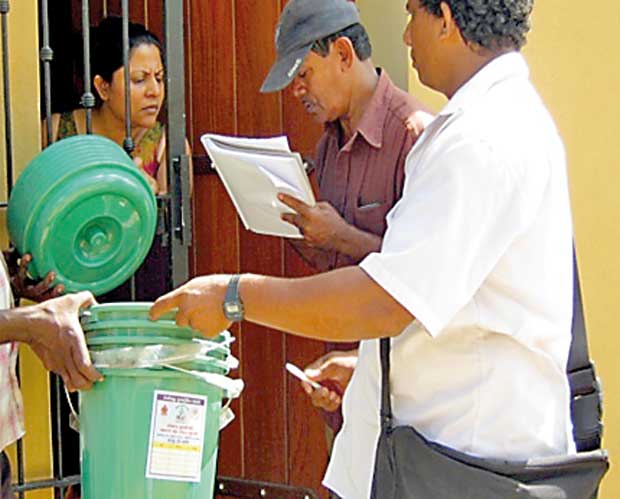
“The main factors that relate to garbage generation are the population and the economic status”
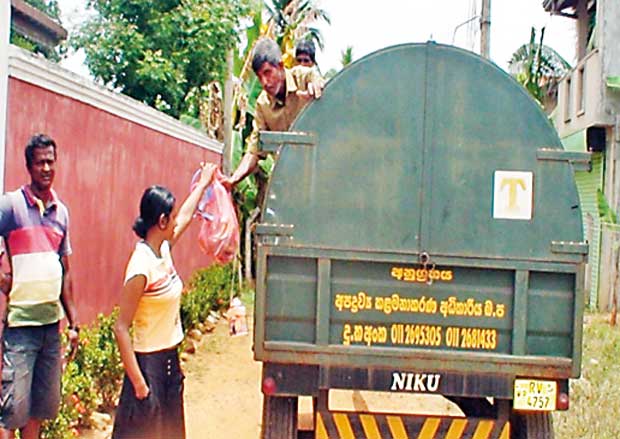
The fact is coherent that Sri Lanka is experiencing a massive garbage crisis and therefore productive actions need to be taken before the condition worsens. Moreover, it is identified that there are 25 dumpsites in the Western Province which are piled up with various types of dirt without a solution for the recycling process. At the same time, it is pleased to know the mapping of a master plan known as the Municipal Solid Waste (MSW) management which will be set to embark in 2018. Until it will be put it to practise, there are ongoing waste management practices as follows.
-
Reduction of garbage generation
-
Source segregation
-
Reusing
-
Recycling
-
Collection
-
Transportation
-
Small /Medium Scale Composting (140 IN SL, 25 in WP)
-
Small/ Medium Scale Bio gas production (no of units 150,000 unit in SL)
-
Small/medium scale Recycling centres
-
Turnkey basis
-
Public Privet Partnership basis
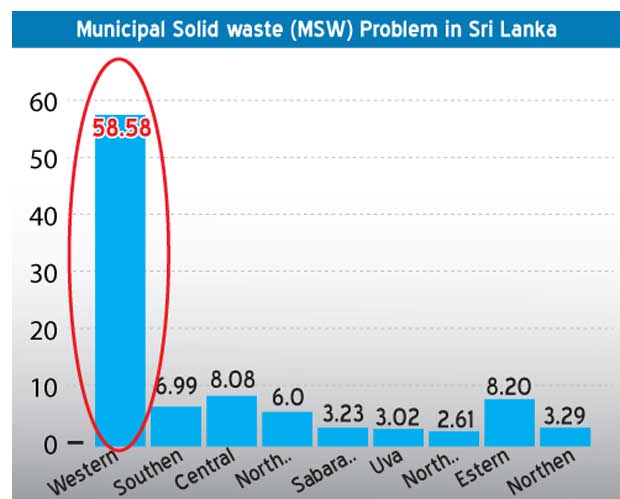
When considering the above actions, we can see that the Western Provincial Waste Management Authority (WPWMA) as a supporting agency to the Local Authority has done a sensible job in monitoring effective methodologies to find solutions to the garbage crisis.
“We have tried on several occasions to find solutions for the garbage issue. But our attempts were unsuccessful due to public protests and the high capital cost. Then we have to seek private and public aid. Therefore, we have endorsed two agreements with Fairway Waste Management (pvt) Ltd which will merge with Germany and Denmark companies and Trilogy ETC (pvt) Ltd. which will merge with OPUS Clean Energy Alliance.” The Director said.
He said that the fist company will commence the project with the garbage capacity of 500mt per day in Karadiyana which would generate 11.5 megawatt (MW) and this will release 89mn kilowatt to the grid per year. As a result of that, it will be adequate to generate electricity for 35000 families. Apart from the generation of electricity, the project is also equipped to generate 41000 tons of liquid fertilizer and 75000 tons of solid fertilizer. The total investment on this project is 73 USD. Then the second company will commence the project with the garbage capacity of 95mt per day at Gampaha, Dambuwatta which would generate 3.4 megawatt (MW). The technology which is to be used for this project is gasification i.e. burning the garbage. The total investment on this project is 30 USD.
In conclusion, the Director of WPWMA expressed his thanks on behalf of the authority to Isura Devapriya, the Chief Minister of the Western Province for the instructions given and the support rendered towards the upcoming project proposals and the issue of garbage. Nevertheless, the Director requests the general public to cooperate with local authorities in segregating and disposing their garbage at appropriate places, so that the muck collectors could collect them conveniently.
Source – Daily Mirror, See more at – http://www.dailymirror.lk/article/Projects-to-check-growing-garbage-crisis-132112.html

Drinking water for drought affected K’gala District
Drinking water is being distributed to 70, 454 drought affected families in 492 Grama Niladari Divisions in 24 Divisional Secretariat Divisions in Kurunegala District, said District Secretary Gamini Illangaratna.
A total of 204, 760 families belonging to 1,610 Grama Niladari Divisions are receiving drought relief. Under this scheme, a family of two receives dry rations worth of Rs 2,000 for two weeks while a family of three or more receive Rs 2,500 worth of dry rations for two weeks which is distributed by cooperatives.
Source – 30/08/2017, Ceylon Today See more at – http://www.ceylontoday.lk/article20170401CT20170930.php?id=6200

